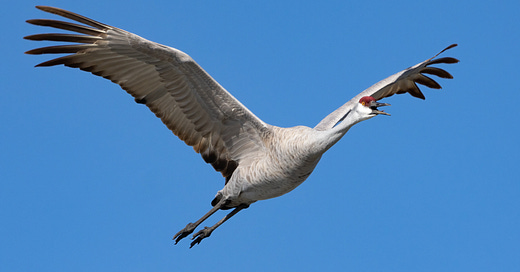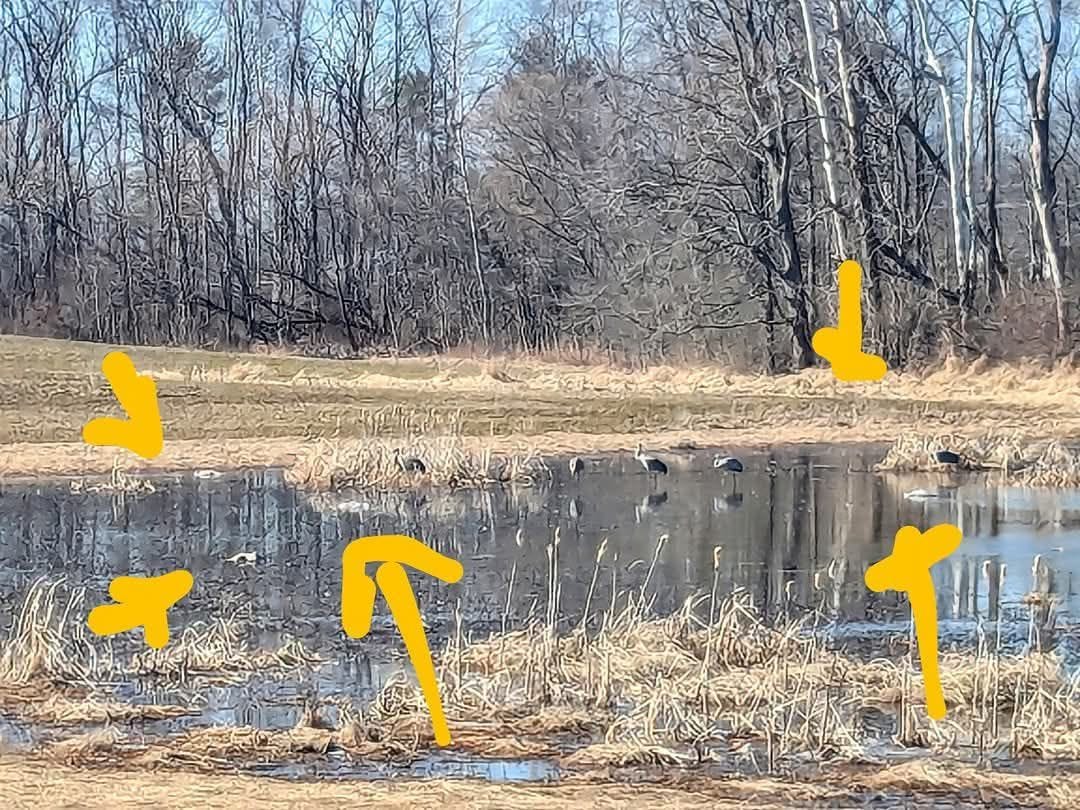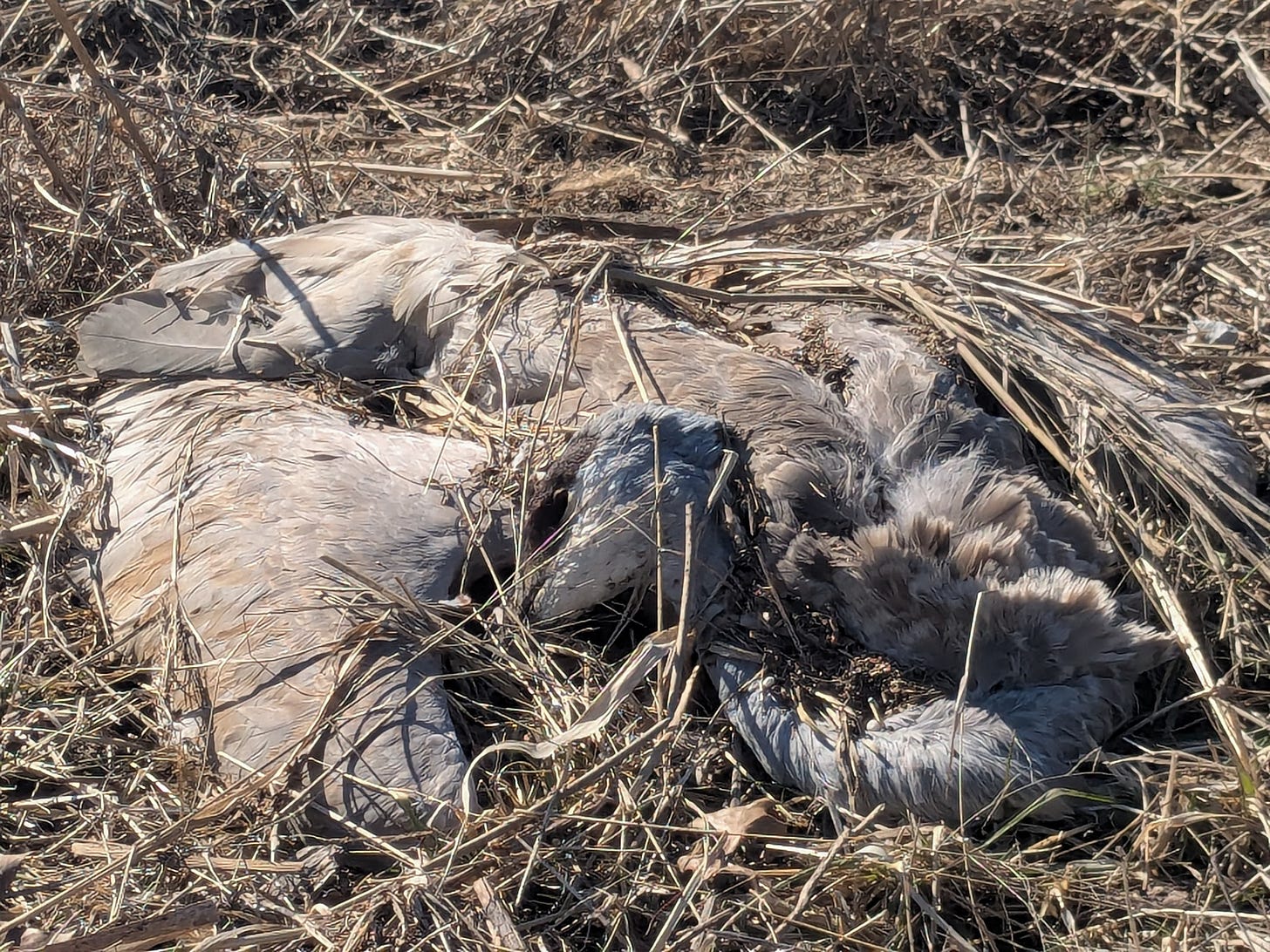Bird Flu Mutes the Trumpet in the Orchestra of Evolution
The Sandhill Crane's spring migration is normally a sign of hope. Not this year.
by Richard Conniff
This past Sunday, Ohio artist Catherine A. Greene and her two children took what she describes as a mini vacation to visit family in Indiana. It did not go as planned.
Driving on Highway 50 in the flood bottoms between Brownstown and Bedford, Indiana, she began to notice “multitudes of dead sand[hill] cranes.” It went on for mile after mile, “with the sick zombie birds wander[ing] among their dead … I've never seen anything like it, it was so many dead birds for miles upon miles. I am crushed by this.”
Some people were picking up the dead, moved by something other than public safety. Greene, posting on social media, did not say if they were wearing proper protective gear. Other cars were stopped along the road, “just staring at the horror. At the worst part, I drove faster because I didn't want the boys to see it and I couldn't unsee it. Help us all if that's what's coming.”
It was of course bird flu, H5N1, which has already killed 150 million birds in this country, but seldom with such a charismatic bird, and in such public circumstances. The Indiana Department of Natural Resources reported 1500 sandhill cranes dead so far this year [SEE UPDATE BELOW], on the northward migration to their breeding grounds. At Fish Lake, near South Bend, 100 dead birds turned up.
Eli Fleace, an avian health specialist with the department advised one person there “to make sure that he and his volunteers are wearing disposable gloves, masks, they're double bagging these birds, putting them in the trash and then disinfecting any equipment that they use, including trailers, your shovels or forks or anything like that.”
Indiana, the nation’s third largest egg producer, has lost 6.5 million birds just since January 1, including 2.6 million chickens at a single farm. The state has described it as the worst animal health emergency in its history. Tennessee and Kentucky have also reported a wave of sandhill crane deaths. In addition to the deaths among wild aquatic populations and commercial and backyard poultry flocks, avian flu has been identified in 68 human cases and one death. At the federal level, the response has been in disarray since the Trump Administration’s mass firings took out key U.S. Department of Agriculture workers specializing in bird flu. Official fret about the price of eggs and see no further.
But there is something about the graceful flight of sandhill cranes and their soul-warming return each spring that makes ordinary humans feel the loss in ways poultry never will. They have been here longer than we have, with the oldest known crane fossil dating from 10 million years ago in Nebraska. The resurgence of the population in recent decades has been a source of hope amid the general decline.
Aldo Leopold, who saw the earlier loss of sandhill cranes as a result of marsh-draining and general habitat loss, wrote about them in A Sand County Almanac: “His tribe, we now know, stems out of the remote Eocene. The other members of the fauna in which he originated are long since entombed with the hills. When we hear his call we hear no mere bird. We hear the trumpet in the orchestra of evolution. He is the symbol of our untambeable past, of that incredible sweep of millennia which underlies and conditions the daily affairs of birds and men.”
Catherine Greenwood clearly felt it, driving through Highway 50 in southern Indiana on Sunday. “I cried so hard,” she wrote, “we won't drive that way home. I didn't want to get out of my car, contaminating my shoes, so the photos lack the horror of what I saw.”
They are bad enough.
I’ll include a poem below in comments. It’s by William Stafford, from his book Even In Quiet Places. He meant the first three lines to capture human feelings. But it’s hard not to imagine that the sandhill cranes are thinking those same thoughts now as they look at the fallen all around them.
UPDATE MARCH 6, 2025
I followed up today with Eli Fleace, a biologist with the Indiana Department of Natural Resources, who is currently their bird flu specialist. Here’s the interview transcript, or you can listen (it’s about nine minutes)
Eli Fleace: Based on our numbers, as of Friday, we're estimating a total of 4585 birds that have died, about 1000 of those are Canada geese, about 1100 are snow geese, and about 2000 are sandhill cranes. And then there's quite a few other species that are affected, just at much lower numbers.
Richard Conniff: How about whooping cranes?
Eli Fleace: So we've been working with the International Crane Foundation to try and get some eyes on the whooping cranes, and so far, we haven't seen any whooping cranes display any signs of illness. So it seems like they're not quite as affected as the Sandhills are …
RC: But they're associating with the Sandhills pretty closely, aren't they?
Eli Fleace: Yeah, they have really high interaction with the Sandhills, so we were kind of shocked that none of them were sick yet. We're hoping that they don't get sick from it at all, but we'll see as time continues.
RC: Yeah, you mean that they might have some sort of natural immunity?
Eli Fleace: Yeah, there it might be that their species is just a little more resistant to the strain. It might be that it takes, like a higher threshold of exposure for them to get sick from it. So we're going to keep watching them. We're going to keep, you know, try to keep eyes on them, to monitor their health. But so far, it doesn't seem like they've been affected.
RC: So all of the birds that have been affected so far are water fowl.
Eli Fleace: Well, technically, we don't consider cranes water fowl, but yeah, water fowl. It's mostly water fowl, but it's also affecting raptors. A few other species like like the sandhill cranes. We're also suspecting it in some American Coots, which are technically a rail species, not a ... they're in the rail family, not in the duck family. And then a couple of gulls, and then I suspected it in some crows. We're getting those crows tested now at the lab, but I suspect that some of these crows had avian influenza.
RC: Why the crows? I mean, I guess the American Coots, don't they hang out with the ducks?
Eli Fleace: Yeah, American Coots usually have a high interaction with waterfowl, other water fowl species. So they typically are interacting with those ducks on lakes. They're swimming around together, sharing food sources. The crows, this winter, we suspect a lot of the crows were scavenging on dead birds. It's possible that they picked up the virus through just scavenging on on animals that died from it.
RC: And your numbers, how do they compare with your neighboring states? Is there anybody keeping an overall track?
RC: As far as I can tell, the National Wildlife Health Center, which is part of the USGS, are the ones who are trying to keep track. USDA is also trying to keep track, but their numbers are really delayed because they have to rely on these some federal labs to do testing and confirmation. And those federal labs are so backed up that it's taking them, you know, months to run some of these tests on some birds. So I think the USGS is keeping track of it. I know Tennessee had a small mortality in Sandhill cranes. It was like 150 to 200 died down there. Kentucky has had a few outbreaks. I know they had some snow geese that died. It seems like Indiana has been hit a little bit harder this year than some of those other states. Part of that's probably because so many Sandhills migrate across Indiana.
RC: Yeah. Okay, anything else that I ought to know?
Eli Fleace: Yeah, if folks find sick or dead wildlife in Indiana, they should report it online here.
RC: And you're telling people not to try to collect them in any way, right?
Eli Fleace: Yeah, we're usually advising people to try and avoid contact where they can. If there's a carcass that absolutely has to be removed, folks can do that by double-bagging it and putting it in the trash. We're just asking that they wear gloves and a mask to do so.
RC: OK, and you're doing this too? You're out collecting them?
RC: We're not doing carcass removals. I'm collecting birds in areas where I want to get those birds tested, but I'm not doing any carcass removals across the landscape. It just the sheer amount of effort it would take to remove all the carcasses. It's pretty huge. And removing those carcasses would not remove the virus off the landscape, because the virus is still circulating in living birds. So even if we were to remove all the carcasses, more would show up, right? So really there's not that much of a point in spending all of that, all those resources, money and staff time, and trying to do these carcass removals.
RC: So what's the prognosis for this? In terms of the the Sandhill cranes,
Eli Fleace: Roughly 2000 have died, based on our reporting system. That might be an underestimate. That 2000 is still a relatively small percentage of their population. You know, these, these birds are migrating across Indiana by the tens of thousands. And so it's a relatively low percentage of their population. I wouldn't expect this to affect their total population going into the future. I don't think that this is really going to affect them too much. It's just at the moment, it's pretty stark. When you look out and you see so many dead ones,
RC: Okay, and is there a risk to poultry from mixing with any of these bird species that are potentially contaminated?
Eli Fleace: If you have domestic poultry? So either you know a commercial flock or a private, just a hobby flock, it's best to try and limit those birds, their interaction with wild birds wherever possible. And the USDA and the Board of Animal Health have some good tips on biosecurity, which is how you know you keep, you keep these, these birds safe from from exposure to outside diseases. And a lot of that is just limiting interaction with wild birds, making sure any equipment you use when you're interacting with your flocks has been disinfected, and trying to keep yourself and your clothes and your shoes clean and disinfected before and after you interact with your flocks, that sort of thing.
RC: Okay, where are those tips available?
Eli Fleace: The USDA has a website called "Defend the Flock."
RC: Great. All right, I think that's all I need to ask you. Eli, thank you very much for taking the time to talk.
Eli Fleace: Yeah. Hey, have a good one.
Richard Conniff’s Substack is not funded by cowardly billionaires, corporate sponsors, or advertisers. I depend on support from readers like you. To receive new posts and support my work, please consider becoming a free or paid subscriber.







Watching Sandhill Cranes
by William Stafford
Spirits among us have departed—friends,
relatives, neighbors: we can’t find them.
If we search and call, the sky merely waits.
Then some day here come the cranes
planing in from cloud or mist—sharp,
lonely spears, awkwardly graceful.
They reach for the land; they stalk
the ploughed fields, not letting us near,
not quite our own, not quite the world’s.
People go by and pull over to watch. They
peer and point and wonder. It is because
these travelers, these far wanderers,
plane down and yearn in a reaching
flight. They extend our life,
piercing through space to reappear
quietly, undeniably, where we are.
“Watching Sandhill Cranes” by William Stafford, from Even In Quiet Places. © Confluence Press, 1996. Reprinted with permission of the author. (buy now)
Richard, Thanks for the article and poem. Here’s another poem with a similar sense of both awe and sadness. It’s best to remain humble.
Wild Geese | Mary Oliver
You do not have to be good.
You do not have to walk on your knees
for a hundred miles through the desert, repenting.
You only have to let the soft animal of your body
love what it loves.
Tell me about despair, yours, and I will tell you mine.
Meanwhile the world goes on.
Meanwhile the sun and the clear pebbles of the rain
are moving across the landscapes,
over the prairies and the deep trees,
the mountains and the rivers.
Meanwhile the wild geese, high in the clean blue air,
are heading home again.
Whoever you are, no matter how lonely,
the world offers itself to your imagination,
calls to you like the wild geese, harsh and exciting–
over and over announcing your place
in the family of things.